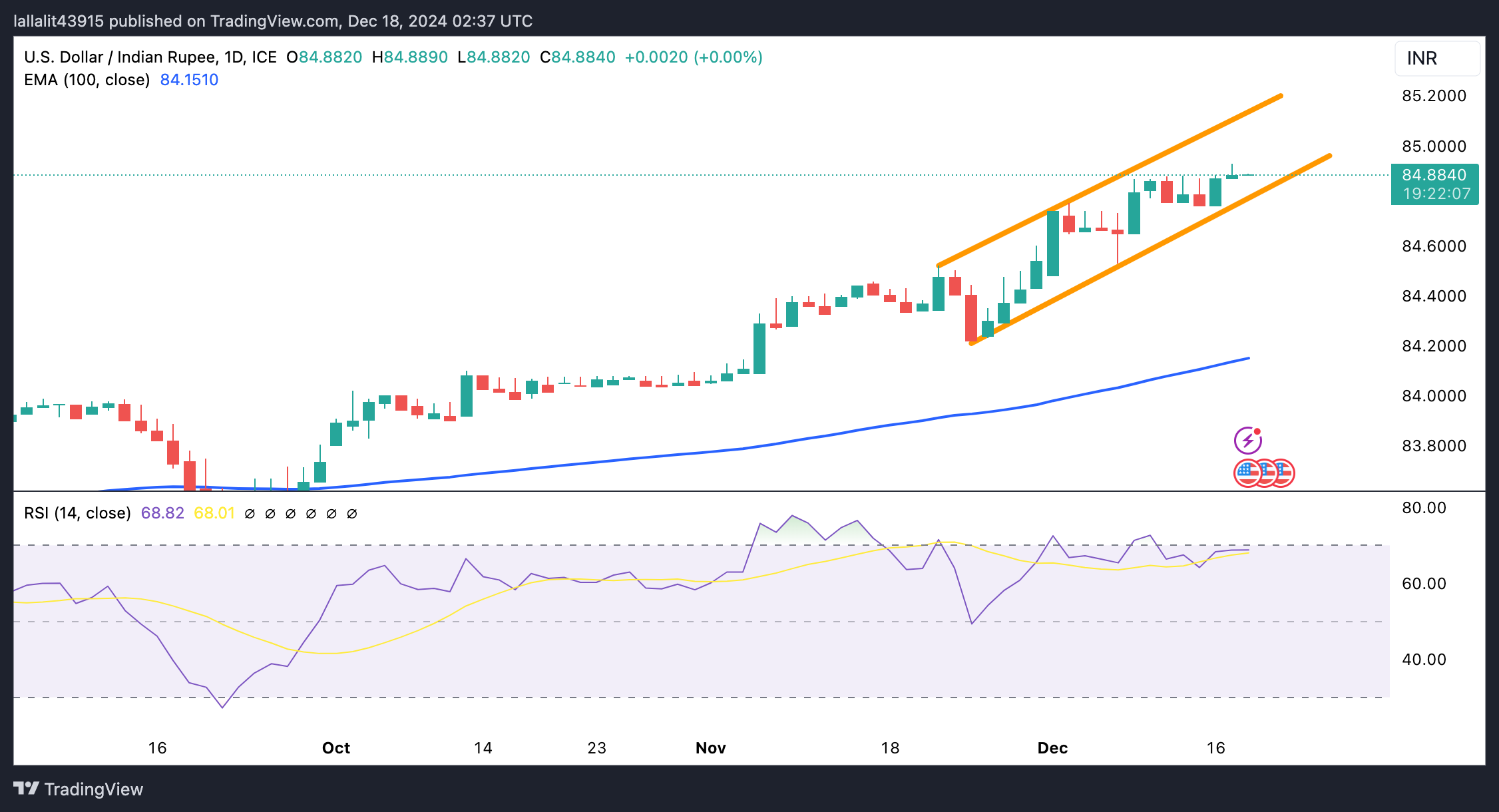- The Indian Rupee holds regular in Wednesday’s Asian session.
- Outflows from native equities and the widening of India’s November merchandise commerce deficit might weigh on the INR.
- The Fed rate of interest determination will take heart stage on Wednesday.
The Indian Rupee (INR) trades on a flat word on Wednesday after reaching a brand new file low of 84.92 within the earlier session. The native foreign money stays on the defensive amid international fund outflows and a muted pattern in home equities. Moreover, the widening of India’s merchandise commerce deficit in November might additional undermine the INR. Nonetheless, the routine international alternate intervention by the Reserve Financial institution of India (RBI) to promote the USD through state-owned banks might forestall the INR from considerably depreciating.
Wanting forward, the US Federal Reserve (Fed) rate of interest determination will probably be within the highlight on Wednesday. The US Fed is predicted to ship 1 / 4 of a proportion level reduce on the December assembly. Merchants will carefully monitor the Fed Chair Jerome Powell’s Press Convention and the Abstract of Financial Projections, or ‘dot plot.’ Any hawkish remarks from the Fed officers would possibly carry the Dollar and contribute to the INR’s draw back.
Indian Rupee flat strains forward of Fed fee determination
- “Whereas weak Asian cues weighed on market sentiment, the file excessive commerce deficit in November pushed the rupee to a brand new low, which triggered buyers to run for canopy, triggering panic promoting in home equities,” famous Prashanth Tapse, Senior VP (Analysis), Mehta Equities Ltd.
- India’s merchandise commerce deficit widened to a file excessive of $37.8 billion in November, in comparison with $27.1 billion in October. In the meantime, Exports fell by 4.9% YoY to $32.1 billion, whereas Imports rose 27% YoY to $69.95 billion through the month below assessment.
- The US Retail Gross sales climbed by 0.7% MoM in November versus a 0.5% improve (revised from 0.4%) prior, in keeping with the US Census Bureau on Tuesday. This determine got here in stronger than the 0.5% improve anticipated.
- The US Industrial Manufacturing declined by 0.1% MoM in November, in comparison with a fall of 0.4% (revised from -0.3%) in October, beneath the market consensus of the 0.3% growth.
- The markets are actually pricing in a virtually 97.1% likelihood of a 25 foundation factors (bps) reduce on the Fed’s December assembly, in contrast with a few 78% likelihood per week in the past, in keeping with the CME FedWatch software.
USD/INR retains the bullish vibe in the long term
The Indian Rupee trades flat on the day. The robust bullish outlook of the USD/INR pair stays in play, characterised by the worth holding above the important thing 100-day Exponential Shifting Common (EMA) on the each day timeframe. The upward momentum is supported by the 14-day Relative Power Index (RSI), which is situated above the midline close to 68.15, suggesting that the additional upside appears to be like beneficial.
The primary upside barrier for USD/INR emerges close to the ascending pattern channel and the psychological stage of 85.00. Sustained buying and selling above this stage might attract patrons and push the pair to 85.50.
On the flip aspect, the decrease boundary of the pattern channel of 84.80 acts as an preliminary assist stage for the pair. Bearish candlesticks that would result in a possible retest of the low of November 25 at 84.22. A breach of the talked about stage might expose 84.15, the 100-day EMA.

Indian Rupee FAQs
The Indian Rupee (INR) is likely one of the most delicate currencies to exterior components. The worth of Crude Oil (the nation is very depending on imported Oil), the worth of the US Greenback – most commerce is carried out in USD – and the extent of international funding, are all influential. Direct intervention by the Reserve Financial institution of India (RBI) in FX markets to maintain the alternate fee steady, in addition to the extent of rates of interest set by the RBI, are additional main influencing components on the Rupee.
The Reserve Financial institution of India (RBI) actively intervenes in foreign exchange markets to take care of a steady alternate fee, to assist facilitate commerce. As well as, the RBI tries to take care of the inflation fee at its 4% goal by adjusting rates of interest. Larger rates of interest often strengthen the Rupee. That is because of the position of the ‘carry commerce’ through which buyers borrow in nations with decrease rates of interest in order to put their cash in nations’ providing comparatively greater rates of interest and revenue from the distinction.
Macroeconomic components that affect the worth of the Rupee embody inflation, rates of interest, the financial progress fee (GDP), the stability of commerce, and inflows from international funding. The next progress fee can result in extra abroad funding, pushing up demand for the Rupee. A much less unfavorable stability of commerce will finally result in a stronger Rupee. Larger rates of interest, particularly actual charges (rates of interest much less inflation) are additionally optimistic for the Rupee. A risk-on surroundings can result in higher inflows of Overseas Direct and Oblique Funding (FDI and FII), which additionally profit the Rupee.
Larger inflation, significantly, whether it is comparatively greater than India’s friends, is usually unfavorable for the foreign money because it displays devaluation by oversupply. Inflation additionally will increase the price of exports, resulting in extra Rupees being offered to buy international imports, which is Rupee-negative. On the identical time, greater inflation often results in the Reserve Financial institution of India (RBI) elevating rates of interest and this may be optimistic for the Rupee, as a result of elevated demand from worldwide buyers. The other impact is true of decrease inflation.
